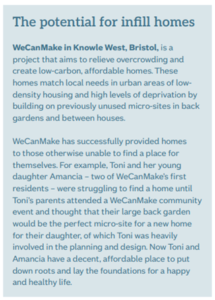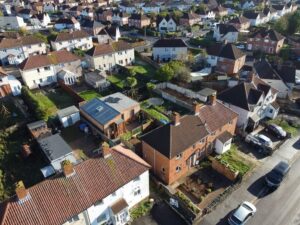Published in July, Decent and affordable homes for all: five proposals for a fairer housing system is our call to the government for urgent but long-lasting change to the housing sector.
At the Nationwide Foundation, our strategy has evolved significantly in the decades since our founding, but our focus now is on housing and making the housing system work for all – that is what our five recommendations are aiming to achieve. Our fourth recommendation is focused on the importance of housing diversification to deliver the number and quality of homes people need:
Why should the government support community-led housing?
Housing diversification, including delivering more community-led housing, must be a key part of delivering the large number of new homes required, alongside large-scale delivery routes. Community-led homes offer local people affordable and decent places to live and help build thriving and connected communities. But the significant role that community-led housing can play in addressing the lack of affordable homes in the UK has been overlooked for too long.

Supporting the scaling up of community-led housing can help increase the supply of genuinely affordable homes in places where they are needed and wanted, providing more people with access to good-quality homes in stable communities that will help them thrive in all aspects of life.
Community-led housing empowers people to do something to improve their areas and own lives – a public good in itself – reinforcing democracy, participation and giving people a sense of agency. The number of community land trusts has risen rapidly in recent years: in 2023, there were 350 active CLTs, with another 209 communities considering or in the process of forming one – up from only 20 active CLTs in 2008. But they are only just beginning to show their true potential. There are barriers to scaling community-led housing that the government must address to unlock this possible source of new and affordable homes.
How can our recommendation be achieved?
To diversify the housing market, potential providers need a level playing field. This means the government must formally recognise community-led housing groups as a legitimate provider of affordable housing for rent. This can be achieved by amending the definition of “affordable housing for rent” in the National Planning Policy Framework to make it easier for organisations which are not Registered Providers, in particular community-led developers, to access finance for developing new affordable homes. There are also opportunities for the CLH sector to influence the Housing and Infrastructure Bill to ensure that it recognises the role and value of community-led housing.
The opportunity is significant. The community-led housing sector aims to scale and provide around 5% of new homes built. To enable more community-led housing projects, the next Affordable Homes Programme should include ring-fenced funding for each stage of the development process, including pre-development finance. In addition, mainstream lenders and financial institutions should be encouraged to offer specialised products for community-led housing projects such as flexible loan terms and favourable interest rates.
National and local government must also maximise opportunities for infill development on small and micro-sites in low density neighbourhoods, for example garages or back gardens
To address the scale of the challenge of the shortfall in homes, we need to mobilise all parts of the housing sector. The potential for small and micro-sites in low-density neighbourhoods to unlock the delivery of community-led affordable homes is significant. There is a lack of data on infill sites, but evidence from the London Assembly suggests London alone has the capacity for 100,000 new homes via infill development. Despite the lack of data, evidence from the WeCanMake project in Bristol suggests that infill development on post-war council estates could also provide over 100,000 new affordable homes across the UK.
Examples of community-led housing schemes:
- CLT Leeds Community Homes is building 34 new affordable homes in Armley, one of the most deprived parts of the city on land that had been derelict since previous council flats had been demolished in the early 2000s. The new community of high-quality homes will be funded in part through a community share offer.
- House prices in the popular rural community of Marshfield in South Gloucestershire are above average for the area. Marshfield CLT (MCLT) is building genuinely affordable housing for local people as well as a potential community-owned renewable energy project aiming to make Marshfield a sustainable village.

Community-led homes are also affordable: The Affordability of Community-Led Homes, published in December 2023 by the Centre for Regional and Economic Research, found that the vast majority of community-led housing groups are predominantly focused on developing more affordable homes. On average, living in the homes in the data set studied cost households an estimated 25% of their incomes. This is well below the 33% to 35% threshold commonly used as a measure of affordability, meaning residents are spending less of their incomes on their homes, reducing the stress and anxiety that often comes with unaffordable housing costs.
Government should work with local authorities to include a process for supporting community-led infill development for affordable housing in Local Plans. These should include making small grants and in-kind resources available to identify appropriate sites, support with planning applications and support in securing funding from public or private sources. Government should also work with local authorities to make good use of sites available through transfer from the local authority Housing Revenue Account below £2m.


